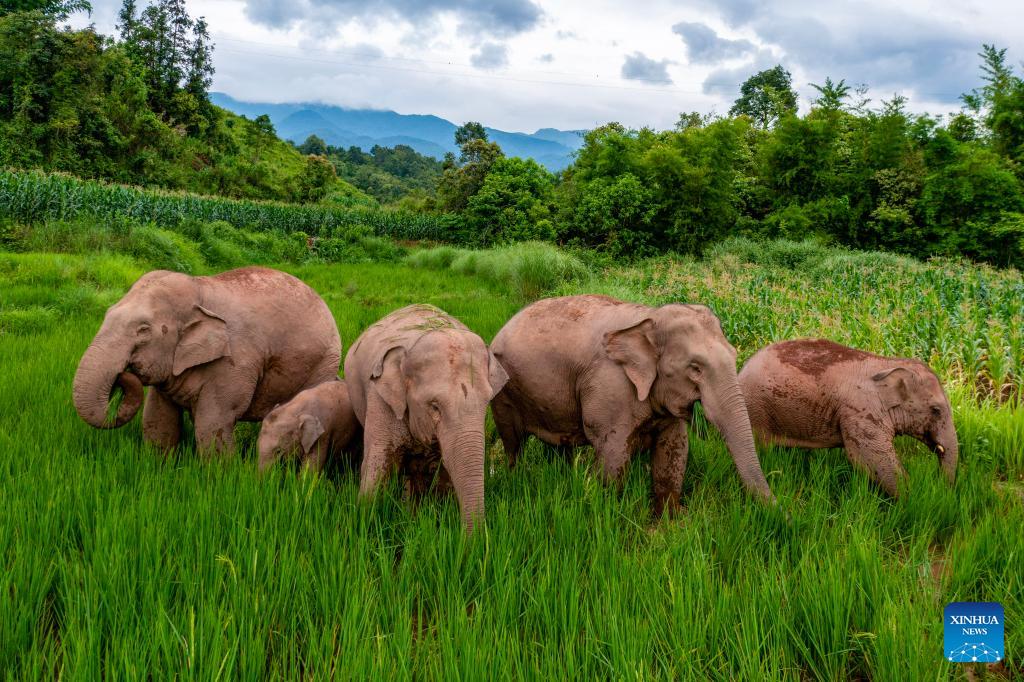
This aerial photo taken on July 19, 2023 shows wild Asian elephants foraging at a paddy rice field
in Jiangcheng County, southwest China's Yunnan Province. [Photo/Xinhua]
The number of wild Asian elephants in Yunnan province has more than doubled over the past 30 years thanks to conservation efforts, according to the Yunnan Forestry and Grassland Bureau.
Ahead of Monday's World Elephant Day, officials said there are now over 300 wild Asian elephants in the province, and their habitat is continuing to expand, with much of the population concentrated in Yunnan's Xishuangbanna Dai autonomous prefecture.
Bao Mingwei, who has worked as an "elephant doctor" for more than two decades, said he has witnessed the population growth firsthand.
"Asian elephants are a first-class nationally protected wild animal in China, and their population here has steadily increased," said Bao, head of the Asian Elephant Rescue and Breeding Center Innovation Studio.
The global spotlight shone on Yunnan's wild elephants in 2020 when a group left the Yunnan Xishuangbanna National Nature Reserve and embarked on a 17-month, 1,300-kilometer journey north to Kunming, the provincial capital. The group's trek captivated people worldwide, with many following the herd's progress online. Local authorities and residents closely monitored and protected the elephants as they made their way back to their habitat in August 2021.
Since their return to the Mengyang area of the reserve, the 15-elephant group has grown. They have occasionally split or rejoined, absorbed new members and integrated with other herds, resulting in the birth of four baby elephants. The herd now numbers over 20 individuals.
"Asian elephants are matriarchal, and male elephants leave the herd before or upon reaching adulthood, so this traveling group was led by a female," said Bao, who was involved in escorting the elephants back to their habitat.
Bao said rescue methods have improved significantly in recent years, with quicker response times and better care for both adult elephants and calves. Since the start of the 14th Five-Year Plan (2021-25), Yunnan has allocated over 2 billion yuan ($279 million) for elephant conservation. Efforts include appointing forest chiefs responsible for elephant protection, setting up safety warning lines, deploying monitoring devices and establishing professional elephant protection teams.
"People's awareness of Asian elephant conservation is growing stronger," Bao said. "Government measures such as insuring crops and compensating farmers for damage caused by elephants have promoted the harmonious coexistence between humans and wild elephants."
Chen Fei, director of the National Asian Elephant Research Center at the National Forestry and Grassland Administration, said the wild elephant population is "very stable and reproducing healthily".
In recent years, Xishuangbanna has also made strides in reintroducing rescued elephants back into the wild. A wild Asian elephant named A Bao, who was rescued in the city of Pu'er in 2018, was successfully released back into its habitat earlier this year after rehabilitation, said Wang Bin, director of the Xishuangbanna Asian Elephant Conservation Management Center.
"We have been tracking A Bao using drones and infrared cameras, and it is in good physical condition," Wang said.
Xishuangbanna has rescued 23 wild Asian elephants, with 15 released back into the wild and eight housed at a rescue center, according to the center.




